
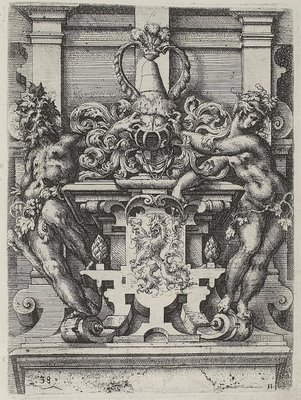





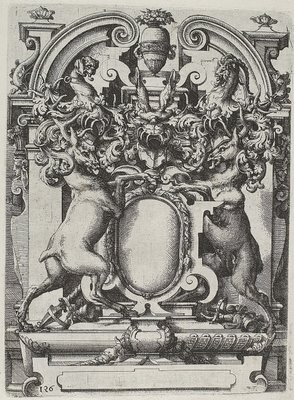



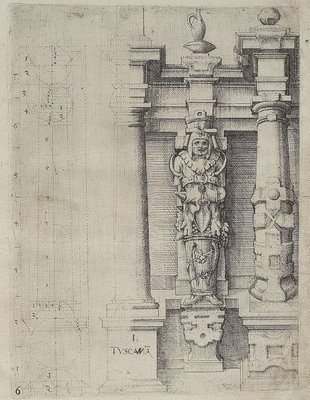

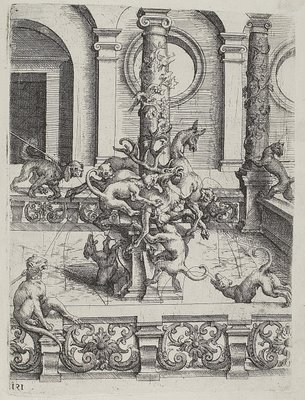
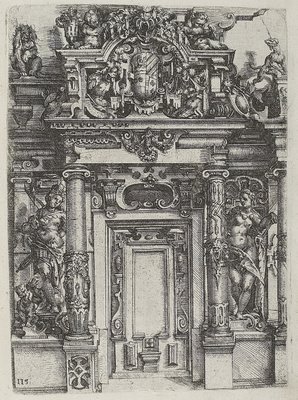


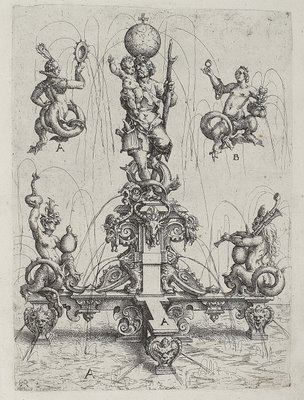
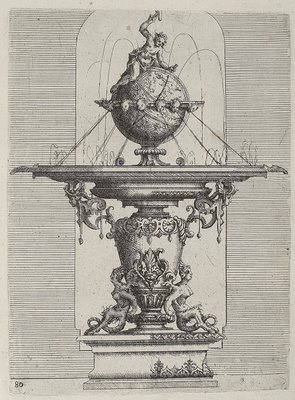
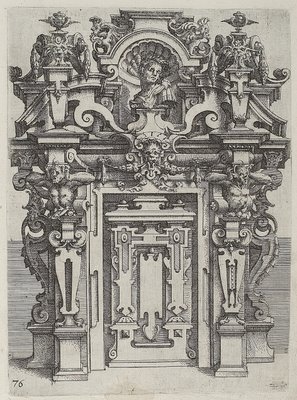


[click to enlarge]
Wendel Dietterlin (1550-1599) was born in Konstanz in southern Germany but moved to the (then) autonomous Strasbourg district where he obtained citizenship during his twenties. Much of the online information seems sketchy both because of scarcity and also dubious translations.
Dietterlin is said to have trained as a painter under Philipp Memberger in Konstanz and may have received building/architectural instruction in Suttgart. His major trade appears to have been fresco painter but he was obviously well schooled in the art of engraving.
Beyond that I think I'll leave the commentary to Harry Francis Mallgrave : 'The Millard J. Millard Architectural Collection, III: Northern European Books (National Gallery of Art, Washington, D.C., 1998) p. 25ff., nos. 28-29' [link or here] -
“One of the most interesting and important architectural works of sixteenth-century northern Europe is the ‘Architectura von Ausstheilung, Symmetria und Proportia der fünff Seulen’ of Dietterlin... [Dietterlin’s] artistic fame and influence was unparalleled in Germany in the first two decades of the seventeenth-century, and in this respect and others, his significance, especially in his dissemination of Renaissance decorative forms in Germany, parallels and even transcends that of Vredeman in the Netherlands.... What makes Dietterlin’s decorative style so unique and important for architecture is twofold: first, the very high artistic quality of the 203 engraved plates; and second, the way in which the painter (as he identifies himself on the title-page) attempts to interpret the Vitruvian and Serlian tradition of classical architecture in a private, lively, and imaginative style that was, as one of his earlier biographers phrased it, ‘almost impressionistic,’ if not a forerunner to the German baroque.
Dietterlin, in effect, mediates or filters the tradition of Vitruvius or Serlio through such column books as that of Blum, but even here important distinctions or departures are already in evidence.... Each of the five books is devoted to one order and iconographic theme based on the Vitruvian explanation of its origin. Each book begins with plates relating the order’s basic geometry or proportions, before passing to its decorative appurtenances with a lively if not sometimes nightmarish sensitivity. Terror and dementia are sometimes the impressions evoked by these images, as Dietterlin combines architectonic, human and animal forms with a pre-Piranesian sense of fantasy and humor that is unparalleled within the architectural literature of this time. There is scarcely a distinction in his forms between what is organic or inorganic, as walls, portals and windows breathe with empathetic life. Humanist architecture for Dietterlin is entirely corporeal, moving, and animate.... The technical or artistic execution of the plates also elevates the book above any other northern treatise of the sixteenth century, but this achievement is so self-evident to the reader that it is scarcely worth noting.”
- 'Architectura von Ausstheilung, Symmetria und Proportia der fünff Seulen' [Architecture of Exhibition, Symmetry and Proportion of the Columns] by Wendel Dietterlin was issued in parts in 1593/4 but was expanded to include more than 200 illustrations for simultaneous publication in Latin, German and French in 1598 and is online in its entirety at Universitätsbibliothek Heidelberg. (the '+' button at the bottom of the illustration pages will open a slightly larger version as a pdf -- I don't think in this case it helps at all)
- See also Part I - I've posted about 20% of the book illustrations in total. Although I tended to save the most bizarre pictures, as is my want, it is a fair representation of the book - the overwhelming majority of the illustrations are of a similar eccentric flavour.
- Artnet.
- Classical order at wikipedia.
- Small biography of Dietterlin (an ancestor of Albert Schweitzer).
- "Sir Banister Fletcher's A History of Architecture" 1896 - this site has pdf background articles on a number of architectural topics : 'The Architecture of the Renaissance and Post-Renaissance in Europe and Russia' is well worth reading if you have an interest.
- Imaginary Design on Dietterlin and Hans Vredeman de Vries.
- The Fontainebleau School: misteraitch: I + II; University of Navarre
- Previously related: Hugues Sambin & Joseph Boillot.



















No comments :
Post a Comment
Comments are all moderated so don't waste your time spamming: they will never show up.
If you include ANY links that aren't pertinent to the blog post or discussion they will be deleted and a rash will break out in your underwear.
Also: please play the ball and not the person.
Note: only a member of this blog may post a comment.